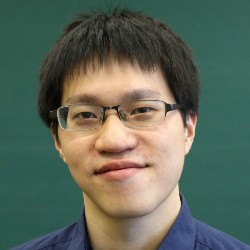
By Josh Baxt
New UC San Diego Computer Science and Engineering (CSE) Assistant Professor Albert Chern brings a mathematical mindset to computer science. In fact, for most of his academic career, math came first.
“My undergraduate studies all the way to my Ph.D. and post-doc were all in mathematics,” said Chern, who started at CSE in 2020. “But during my Ph.D. such studies, I started working on problems in computer graphics.”
Chern received his Ph.D. in applied and computational mathematics from Caltech and conducted his postdoc at the Technical University of Berlin. There, at the Institute of Mathematics, he focused on the computational aspects of differential geometry, which have tremendous impact on computer graphics.

Chern wasn’t sure which discipline to pursue: computer science or math. Computer graphics offered him the best of both worlds, as well as the opportunity to express his artistic side.
“Computer graphics has a lot of similar problems to mathematics, such as solving fluid dynamics,” said Chern. “We want to simulate physically-based animations, so we can create these beautiful simulations.”
The computer science culture also appealed to Chern. He felt it moved a little quicker than math and was more open to new ideas, particularly when addressing fluid dynamics and other issues.
He knew his work in geometry processing, also called mesh processing, could help create and manipulate complex 3D shapes.
“For us, it's really studying the differential geometric aspects of these shapes,” said Chern. “How do we efficiently simulate some physically realistic looking fluid dynamics or elasticity to create these physically-driven animations for movie effects.”
Quite often, people use calculus or linear algebra to address these issues, but Chern wants to leverage more advanced mathematical techniques to gain deeper insights into these problems.

One of these is geometric mechanics, which looks past using X, Y, Z coordinates to configure objects in space (looking at you, René Descartes). More advanced math has developed coordinate-free descriptions, a more abstract way of looking at the world that gives Chern and others more freedom when developing graphics.
“In that space, we see these variable equations actually look quite similar to a Schrodinger equation in quantum mechanics,” said Chern. “This was actually known in the 1920s, but it has never been explored to compute fluid dynamics. We’re trying to unify the Schrodinger and Navier Stokes equations to demonstrate some cool tricks we can do.”
When interviewing for the job, Chern was impressed with CSE’s Center for Visual Computing and feels his work in graphics can readily complement existing expertise in rendering, machine learning and computer vision. Coming to CSE also solidified his direction.
“When I was searching for a job I wasn’t sure whether I was moving towards mathematics or computer science,” said Chern. “It was one of those internal struggles.”

Like everyone else, Chern had to adapt to remote classrooms. He likes to illustrate his lectures with images, rather than text, to help get these complex points across.
“I was looking forward to having a giant blackboard, explaining my theories and having eye contact with students, but that was not going to happen with remote teaching.” Chern tries to overcome these shortcomings by encouraging heavy use of the chat feature.
With his mathematical background, Chern has had to feel his way I bit. But he’s finding his students are seeing the potential applications beyond what they’re learning in class and that’s generated a lot of excitement.
“I wasn’t sure whether it was too much math or too little,” he said. “But as long as I can supply the right motivation, and show my students how it can really be fun, they see how useful it can be.”

